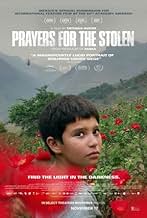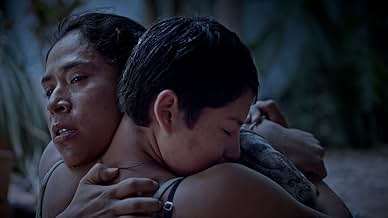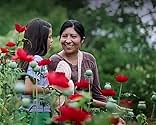PUNTUACIÓN EN IMDb
7,3/10
4,5 mil
TU PUNTUACIÓN
La vida en una ciudad en guerra vista a través de los ojos de tres jóvenes, quienes han iniciado el camino hacia la adolescencia.La vida en una ciudad en guerra vista a través de los ojos de tres jóvenes, quienes han iniciado el camino hacia la adolescencia.La vida en una ciudad en guerra vista a través de los ojos de tres jóvenes, quienes han iniciado el camino hacia la adolescencia.
- Dirección
- Guión
- Reparto principal
- Premios
- 23 premios y 36 nominaciones en total
Reseñas destacadas
10aarpcats
Watching this movie reminded me of the blurry photographs of British children playing in the ruins of London during the Blitz. If a building were bombed today, the unsafe structure would be guarded by cops to keep the children from being buried in the rubble. But, when the city is being bombed every night, what's the difference in whether a child dies from bombíng or under a pile of loose bricks? War brings death and death becomes normal.
In the bucolic and gorgeous mountains of Jalisco, war is constant and unending. Flickering fire flies have been replaced by the lights of cell phones as villagers try desperately to get a call "to the other side" for money to leave. Staying means enslavement to the cartel and losing your daughters to brutal sex trafficking. Instead of bombs, the cartels and the useless police rain terror on the adults in the village. Everyone knows a dead girl, and everyone knows how to harvest opium. And everyone knows to run when the US helps Mexico spray chemicals on the poppy crops.
Yet, just as the London kids entertained themselves with soccer, school, story telling and friendships, so too do the children in the village in Jalisco. What terrifies their parents simply is business as usual to them. They can't help growing up in war, but they are growing up. They want to dance, go to rodeos, date - every day things that are death defying in Jalisco.
It's an excellent movie about how the human spirit survives the unthinkable.
I want to tie Americans to chairs to help them understand exactly what American drug habits, the War on Drugs and the crisis in Central America is doing to desperate, terrified people. I want them to understand that they aren't coming heee for handouts. I want them to understand that they are coming here to stay alive. I want them to see children burned with American pesticides.
The acting is astonishing, the cinematography brilliant and the story heartbreaking. And this story happens every day in Mexico.
In the bucolic and gorgeous mountains of Jalisco, war is constant and unending. Flickering fire flies have been replaced by the lights of cell phones as villagers try desperately to get a call "to the other side" for money to leave. Staying means enslavement to the cartel and losing your daughters to brutal sex trafficking. Instead of bombs, the cartels and the useless police rain terror on the adults in the village. Everyone knows a dead girl, and everyone knows how to harvest opium. And everyone knows to run when the US helps Mexico spray chemicals on the poppy crops.
Yet, just as the London kids entertained themselves with soccer, school, story telling and friendships, so too do the children in the village in Jalisco. What terrifies their parents simply is business as usual to them. They can't help growing up in war, but they are growing up. They want to dance, go to rodeos, date - every day things that are death defying in Jalisco.
It's an excellent movie about how the human spirit survives the unthinkable.
I want to tie Americans to chairs to help them understand exactly what American drug habits, the War on Drugs and the crisis in Central America is doing to desperate, terrified people. I want them to understand that they aren't coming heee for handouts. I want them to understand that they are coming here to stay alive. I want them to see children burned with American pesticides.
The acting is astonishing, the cinematography brilliant and the story heartbreaking. And this story happens every day in Mexico.
Horror, even the weird and most brutal films are just that, scary films. Noche de Fuego, based on Jeniffer Clement's "Prayers for the Stolen" is a radical departure from films that tackle the world of drugs and its consequences. Tatiana Huezo's film is an introspective into the life of three children as they grow in a world of violence in the mountains of Mexico where most people work in the world of opium harvesting. Harrowing and crude, the film goes into the depths of humanity, seen from the eyes of three young girls who fear the possible threats of only "living" as kids. The performances are stunning. The casting is superb. The DP created a visual masterpiece. With Tati at the helm, this rollercoaster of a film, will keep you nailed to your seat as it will be engraved in your mind for years to come. At Cannes, the film had wild reviews but, above all, an audience who couldn't believe what they experienced through the first Festival that chose it. A complete success!
Tatiana Huezo Sánchez who is best known for her documentaries, turns her attention to fiction with a coming of age drama based on Jennifer Clement's novel of the same title. It tells the story of Ana and her two best friends who discover a shocking reality - and a hostile world amidst the drug trafficking in Mexico. It gives a personal touch to something we hear at a distance on the internet. From the first moments of the film, Tatiana chooses to film this through the details, her camera focussing on the minutiae of the environment. She plunges us into an peaceful atmosphere, behind the lush green setup, we feel a discomfort and a lively tension underlying between the villagers. They depends on poppy harvest to make ends meet. There are semi-detached houses with hiding place and girls are made to sport boyish haircuts to escape from the eyes of human traffickers. There is absolutely no hope for the little girls and they tend to get worse as time goes on.
Initially, I was just expecting another usual documentary with realism tag, while storyline does follow the formula, its the treatment that appealed. It has a lot more than one would expect. It seems like a tearjearker war film, but when you dive into it you'll likely see a different pov. The pacing is easy and there is no rush on Tatiana's behalf to get to 'the story', as it were, but rather a strong sense of atmosphere and indulges the viewer through this lack of urgency. It contains an atmospheric and evocative cinematography by Dariela Ludlow Deloya. It is supported with subtle score by Jacobo Lieberman and Leonardo Heiblum. As well as adequate sound design by Lena Esquenazi.
Overall, it is a great proof that this film depicts childhood and adolescence of three girls is by no means exaggerated. It's blends early Jorge Silva, Marta Rodríguez, Alanis Obomsawin's style and is almost like a companion piece to Identifying Features (2020) and Birth Certificate (1961); both thoroughly bleak and does scream for help with no chance for hope.
Initially, I was just expecting another usual documentary with realism tag, while storyline does follow the formula, its the treatment that appealed. It has a lot more than one would expect. It seems like a tearjearker war film, but when you dive into it you'll likely see a different pov. The pacing is easy and there is no rush on Tatiana's behalf to get to 'the story', as it were, but rather a strong sense of atmosphere and indulges the viewer through this lack of urgency. It contains an atmospheric and evocative cinematography by Dariela Ludlow Deloya. It is supported with subtle score by Jacobo Lieberman and Leonardo Heiblum. As well as adequate sound design by Lena Esquenazi.
Overall, it is a great proof that this film depicts childhood and adolescence of three girls is by no means exaggerated. It's blends early Jorge Silva, Marta Rodríguez, Alanis Obomsawin's style and is almost like a companion piece to Identifying Features (2020) and Birth Certificate (1961); both thoroughly bleak and does scream for help with no chance for hope.
A bittersweet innocence exists among a group of young girls growing up in a drug-controlled country. One viewing of this excellent film will convince even the most stubborn-minded of the main reason that some of Mexico's inhabitants are fleeing to America to seek a better life.
When I went to see this movie, I knew it was gonna be tough, but I didn't imagine it to make me cry that much. The story really goes to the heart.
Also, the child actors did a wonderful job!
Also, the child actors did a wonderful job!
¿Sabías que...?
- CuriosidadesOfficial submission of Mexico for the 'Best International Feature Film' category of the 94th Academy Awards in 2022. It made the shortlist but did not end up nominated.
- Banda sonoraCariñito
Written by Ángel Aníbal Rosado
Performed by Zindu Cano, Vivir Quintana, Alejandro Díaz, Leo Soqui, Rodrigo Garibay, Alfonso Figueroa, Leonardo Heiblum and Jacobo Lieberman
Selecciones populares
Inicia sesión para calificar y añadir a tu lista para recibir recomendaciones personalizadas
- How long is Prayers for the Stolen?Con tecnología de Alexa
Detalles
- Fecha de lanzamiento
- Países de origen
- Sitios oficiales
- Idioma
- Títulos en diferentes países
- Prayers for the Stolen
- Localizaciones del rodaje
- Empresas productoras
- Ver más compañías en los créditos en IMDbPro
- Duración1 hora 51 minutos
- Color
- Relación de aspecto
- 1.78 : 1
Contribuir a esta página
Sugerir un cambio o añadir el contenido que falta























